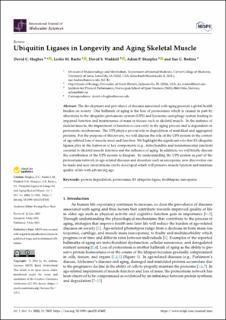| dc.contributor.author | Hughes, David C. | |
| dc.contributor.author | Baehr, Leslie M. | |
| dc.contributor.author | Waddell, David S. | |
| dc.contributor.author | Sharples, Adam | |
| dc.contributor.author | Bodine, Sue C. | |
| dc.date.accessioned | 2022-12-01T09:33:06Z | |
| dc.date.available | 2022-12-01T09:33:06Z | |
| dc.date.created | 2022-08-26T18:14:45Z | |
| dc.date.issued | 2022 | |
| dc.identifier.citation | International Journal of Molecular Sciences. 2022, 23(14), Artikkel 7602. | en_US |
| dc.identifier.issn | 1661-6596 | |
| dc.identifier.uri | https://hdl.handle.net/11250/3035238 | |
| dc.description | This article is an open access article distributed under the terms and conditions of the Creative Commons Attribution (CC BY) license (https://creativecommons.org/licenses/by/4.0/). | en_US |
| dc.description.abstract | The development and prevalence of diseases associated with aging presents a global health burden on society. One hallmark of aging is the loss of proteostasis which is caused in part by alterations to the ubiquitin–proteasome system (UPS) and lysosome–autophagy system leading to impaired function and maintenance of mass in tissues such as skeletal muscle. In the instance of skeletal muscle, the impairment of function occurs early in the aging process and is dependent on proteostatic mechanisms. The UPS plays a pivotal role in degradation of misfolded and aggregated proteins. For the purpose of this review, we will discuss the role of the UPS system in the context of age-related loss of muscle mass and function. We highlight the significant role that E3 ubiquitin ligases play in the turnover of key components (e.g., mitochondria and neuromuscular junction) essential to skeletal muscle function and the influence of aging. In addition, we will briefly discuss the contribution of the UPS system to lifespan. By understanding the UPS system as part of the proteostasis network in age-related diseases and disorders such as sarcopenia, new discoveries can be made and new interventions can be developed which will preserve muscle function and maintain quality of life with advancing age. | en_US |
| dc.language.iso | eng | en_US |
| dc.subject | E3 ubiquitin ligase | en_US |
| dc.subject | healthspan | en_US |
| dc.subject | protein degradation | en_US |
| dc.subject | proteostasis | en_US |
| dc.subject | sarcopenia | en_US |
| dc.title | Ubiquitin ligases in longevity and aging skeletal muscle | en_US |
| dc.type | Peer reviewed | en_US |
| dc.type | Journal article | en_US |
| dc.description.version | publishedVersion | en_US |
| dc.rights.holder | © 2022 by the authors | en_US |
| dc.source.pagenumber | 23 | en_US |
| dc.source.volume | 23 | en_US |
| dc.source.journal | International Journal of Molecular Sciences | en_US |
| dc.source.issue | 14 | en_US |
| dc.identifier.doi | 10.3390/ijms23147602 | |
| dc.identifier.cristin | 2046392 | |
| dc.description.localcode | Institutt for fysisk prestasjonsevne / Department of Physical Performance | en_US |
| dc.source.articlenumber | 7602 | en_US |
| cristin.ispublished | true | |
| cristin.fulltext | original | |
| cristin.qualitycode | 1 | |
